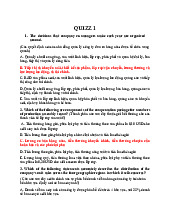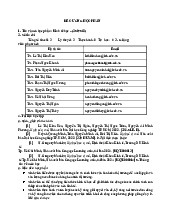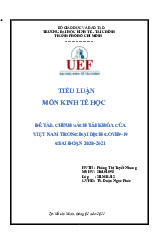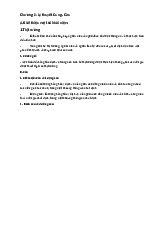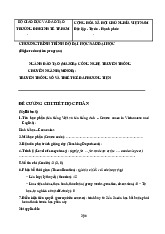









Preview text:
lOMoAR cPSD| 47305584
University of Economics HCM City (UEH) COURSE SYLLABUS
Introduction to Macroeconomics Fall Aug 2021 lOMoAR cPSD| 47305584
Introduction to Macroeconomics 1. COURSE STAFF
Instructor: Nguyễn Thanh Triều, MA, Mphil in Economics Telephone: 0903996150 E-mail: trieunt@ueh.edu.vn
Should the students wish to meet the staff outside the consultation hours, they are advised
to make appointment in advance. 2. COURSE INFORMATION 2.1 Units of Credit
This course is worth 3 credits.
2.2 Relationship of this course to others
Macroeconomics focuses on problems of an economy as a whole such as economic
growth and recession, inflation, unemployment, budget deficit and trade deficit. However,
the course of macroeconomics will use many concepts of microeconomics and has
something to do with algebra as well as geometry. So to a large extend, the course has
close relation to Microeconomics and Calculus. It would be good if the students
completed courses of Microeconomics and Calculus before studying Macroeconomics.
2.3 Approach to learning and teaching
Employing the interactive learning and problem-based teaching approach, this course
emphasizes the interaction between lecturers and students. The lecture materials will be
uploaded in Blackboard to help the students to preview the materials and to concentrate on
listening and critical thinking during the lecture. This will help students to interact with the
lecturer during the classroom. The sessions for presentations and discussions comprise case
studies as well as answering some theoretical and conceptual questions, which help the
students to see how the concepts are applied in the real context. In some cases, students
will present the case to the class and discuss with the peers.
3. COURSE AIMS AND OUTCOMES 3.1 Course Aims
Knowledge in the subject would enable the students not only to understand various broad
economic issues of a country or a region but also to evaluate macroeconomic policies as
well as economic fluctuations both in a country and in the world. The subject also provides
the students with necessary abilities to evaluate economic variables as a whole. All of this
helps the students plan for a company’s short- run and long-run development more
effectively with consideration of effects of the government’s macroeconomic policies. lOMoAR cPSD| 47305584
Introduction to Macroeconomics
3.2 Student Learning Outcomes
After completing the course, students should have developed skills in
- Understanding four macroeconomic issues and how they are important to a
country’seconomic development.
- Knowing how to measure economic growth rate or recession, inflation,
unemployment,and budget deficit and trade deficit in an economy
- Understanding macroeconomic policies such as: fiscal policy, monetary policy,
externalpolicy and income policy.
After the course, the students will be able to:
- Analyze the economic situation in their country and develop plans for effective response.
- Measure a country’s economic performance and macroeconomic indicators such as
unemployment, inflation, balance of payment, etc.
- Understand the effect of various kinds of the government policies on the economy
and develop activities to deal with the negative effects.
In generic terms, students completing this course are likely to achieve the following attributes:
• Applied research. Conduct, write and present applied research relevant to this course.
• Situational exploration. Critically appreciate situations, in terms of their factual,
political, temporal, and cultural dimensions.
• Problem resolution. Structure and propose solutions to problems that either enable
the government to adjust the economy as a whole or help a company to successfully
response to changes in macro-environment..
• Argument and reasoning. Analyze, evaluate and construct arguments employing
different modes of reasoning and different types of evidence.
• Disciplinary and multidisciplinary perspective. Bring disciplinary and
multidisciplinary perspectives in straightening out situations and projecting possible outcomes.
3.3 Teaching Strategies
The learning system in this course consists of lectures and scheduled
presentations/discussions. Lectures elaborate the appropriate theoretical content in the
textbook and readings. Classes provide a more detailed and refined analysis of both
concepts and applied materials. Classes are strongly oriented towards interactive discussion
of the text and cases. In order to gain the most from the lectures and class activities, the
assigned text/reading should be read before the lecture to participate in the discussions. 3 lOMoAR cPSD| 47305584
Introduction to Macroeconomics
From the second week, the students will need to form small discussion groups (5
students/group) which will take turns in presenting the assigned cases each week. However,
all students are required to take active part in the discussions in class. Look at articles and
clippings from business sections of relevant electronic and print media which are relevant
to the presentation topic. The students should explain how the material relates to the theory
discussed in the text. Discuss with group members as to the common strategy for sourcing,
documenting, analyzing and presenting cases each week - for which a basic minimum
interaction will be necessary. For the audience, it is important that they contribute to the
case by getting additional information carefully beforehand so that they are fully familiar
with the materials, and are prepared to participate in the discussions.
4. STUDENT RESPONSIBILITIES AND CONDUCT 4.1 Workload
It is expected that the students will spend at least six hours per week studying this course.
This time should be made up of reading, researching, working on exercises and problems,
and attending classes. In periods where they need to complete assignments or prepare for
examinations, the workload may be greater.
Over-commitment has been a cause of failure for many students. They should take the
required workload into account when planning how to balance study with part-time jobs and other activities. 4.2 Attendance
Regular and punctual attendance at lectures and seminars is expected in this course.
University regulations indicate that if students attend less than eighty per cent of scheduled
classes they may be refused from final assessment. Exemptions may only be made on medical grounds.
4.3 General Conduct and Behavior
The students are expected to conduct themselves with consideration and respect for the
needs of the fellow students and teaching staff. Conduct which unduly disrupts or
interferes with a class, such as ringing or talking on mobile phones, is not acceptable and
students will be asked to leave the class. 4.4 Keeping informed
The students should take note of all announcements made in lectures or on the course’s
drive. From time to time, the lecturer will send important announcements to their university
e-mail addresses without providing a paper copy. The students will be deemed to have received this information. lOMoAR cPSD| 47305584
Introduction to Macroeconomics 5. LEARNING ASSESSMENT 5.1 Formal Requirements
In order to pass this course, the students must:
• achieve a composite mark of at least 5; and
• make a satisfactory attempt at all assessment tasks (see below). 5.2 Assessment Details
Mid-Term Exam (40 multiple choice questions in 60 minutes) 25% Attendance
(No absence without permission) 10%
Group Assignments (Writing an essay) 15%
Final Exam (50 multiple choice questions in 75minutes) 50% Total 100%
5.3 Project Report (Written Assignment)
The students are required to submit a project report in groups of five (5) on one topic.
Length and Style: 6 to 10 A4 pages, excluding footnotes, figures and references. The format
for assignments is to be 1.5 spaced with 2 cm margins and font size of 12 cpi. Please show
all details on the cover sheet.
Tentative structure of the assay:
What is the topic? How is it important?
Theoretical background and empirical evidences relating to the topic?
What has been happening in the reality?
What would you suggest to improve the situation?
The project will be assessed for analytical content and presentation. The same marks will
be awarded to all students in the same group. All work must be original and must not have
been submitted for any other subject or course here or elsewhere. Copying or plagiarizing
works of other authors, including your fellow students or cutting and pasting from the
internet and other sources is an offence and will be seriously penalized.
Due Date: The project report is due at (time) pm on (date, day). Assignments are to be
submitted to the lecturer via LMS.
• Late work will be penalized at the rate of 20 percentage points per week day.
• Students must keep copies of all work submitted.
5.4 Assignment Submission Procedure
It is essential that you submit all your assignment tasks on time via the appropriate
procedures. You should submit your written assignment to the tutor or lecturer in the
beginning of class that your group will present. 5 lOMoAR cPSD| 47305584
Introduction to Macroeconomics Procedure
i) Attach a copy of the Assignment Cover Sheet to be found at the end of this document
ii) Make the copy of the assignment for safe keeping iii) Hand in your assignment to
the tutor or lecturer iv) You may not submit assignment via email or by fax
5.5 Marking criteria (project report and case presentation) Marking Criteria
Marks Learning outcomes/attributes
Quality of arguments: 2 Ability to give compelling arguments and relevance, logic and
cohesion reasoning to support analysis
Use of frameworks to 2 Ability to structure problems in accordance support analysis with
theoretical frameworks and resolve them
Use of case evidence to 2 Ability to conduct applied research to gather support analysis
data/information pertaining to the case Originality and usefulness of 2 Ability to engage in creative problem the analysis solving skills Organization, clarity of 2
Clarity of vision expression, editing etc.
6. ACADEMIC HONESTY AND PLAGIARISM
Plagiarism is the presentation of the thoughts or work of another as one’s own (definition
proposed by the University of Newcastle). Examples include:
- direct duplication of the thoughts or work of another, including by copying work,
or knowingly permitting it to be copied. This includes copying material. Ideas or
concepts from a book, article, report or other written document (whether published
or unpublished), composition, artwork, design, drawing, circuitry, computer
program or software, web site, Internet, other electronic resource, or another
person’s assignment without appropriate acknowledgement;
- paraphrasing another person’s work with very minor changes keeping the meaning,
form and/ or progression of ideas of the original;
- piecing together sections of the work of others into a new whole;
- presenting an assessment item as independent work when it has been produced in
whole or part in collusion with other people, for example, another student or a tutor;
The inclusion of the thoughts or work of another with attribution appropriate to the
academic discipline does not amount to plagiarism.
Students are also reminded that careful time management is an important part of study
and one of the identified causes of plagiarism is poor time management. Students should lOMoAR cPSD| 47305584
Introduction to Macroeconomics
allow sufficient time for research, drafting and the proper referencing of sources in
preparing all assessment items. 7. STUDENT RESOURCES 7.1 Course Resources
Please note that it is very important to gain familiarity with the subject matter in the
readings and cases prior to attendance in classes. Textbook:
N.Gregory Mankiw (2004, 2008, 2012, 2017), Principles of Economics, Sixth, Seventh, Eighth Editions. Reference Books:
Other Macroeconomics Textbooks.
Additional materials provided in drive
The lecturer will attempt to make lecture notes and additional reading available on the
drive. However this is not an automatic entitlement for students doing this subject. Note
that this is not a distance learning course, and you are expected to attend lectures and take
notes. This way, you will get the additional benefit of class interaction and demonstration. Recommended Internet sites GSO IMF WORLD BANK
UNCTAD (United Nations Conference on Trade and Development)
WTO (World Trade Organization)
ADB (https://www.adb.org/publications/key-indicators-asia-and-pacific-2020) Business Week The Economist Fortune Forbes
7.2 Other Resources, Support and Information
Additional learning assistance is available for students in this course and will be made
available in drive. Recommended articles will be duly informed to the students.
8. COURSE SCHEDULE Class
Topic Learning materials and activities 1 Course Orientation Textbook, Chapter 10, 6e Measuring a nation’s income Measurement of GDP Case Study: Components of GDP International differences in 7 lOMoAR cPSD| 47305584
Introduction to Macroeconomics Characteristics of GDP GDP Real versus Nominal and Economic GDP Well-Being GDP and 2 Measuring the Cost of Living Textbook, Chapter 11, 6e The Consumer Price Index
Correcting Economic Variables for the Effects of Case Study: Inflation What is in the CPI Basket?
GDP Deflator versus Consumer Price Index P.220
Real and Nominal Interest Rate
Unemployment and Its Natural Rate Textbook, Chapter 15, 6e Identifying Unemployment Case Study: Henry Ford and
Job Search the Very generous $5-a-day. Minimum-Wage Laws P.316.
Unions and Collective Bargaining Theories of Efficiency Wages 3 Production and Growth Textbook, Chapter 12, 6e
Economic Growth around the World
Productivity: Its Role and Determinants Case Study:
Economic Growth and Public Policies. Are natural resources limit
The Importance of the Long-term growth. to growth? P. 242 Textbook,
Saving, Investment and the country’s financial system Chapter 13, 6e
Financial institutions in the US. Economy
Saving, Investment in the national income Case Study: Accounts
History of US Government Market for loanable fund Debt. P.274 4 The Monetary System Textbook, Chapter 16, 6e The Meaning of Money Case Study: The Federal Reserve System Banks and the Money Supply Bank Runs and the Money Supply. P.340 5 Money Growth and Inflation Textbook, Chapter 17, 6e
The Classical Theories of Inflation The Costs of Inflation 6
Open- Economy Macroeconomics: Basic Concepts Textbook, Chapter 18, 6e
The International Flows of Goods and Capital Case Study:
The Price of International Transactions: Real and Nominal Exchange Rate The Nominal Exchange rate
The First Theory of Exchange rate determination: during a hyperinflation. Purchasing Power Parity lOMoAR cPSD| 47305584
Introduction to Macroeconomics Quality of Life. P.211 7
A Macroeconomic Theory of the Open Economy. The
Supply and Demand for Loanable Funds and for Aggregate Foreign Currency Exchange Supply Curve
Equilibrium in the Open Economy (AS)
How policies and Events affect an Open Two Economy causes of
Textbook, Chapter 19, 6e Case Study: economic fluctuations
Capital flows from China. P. 415 Textbook, Chapter 20, 6e
Mid-term exam 60 minutes – Open-book exam. 8
Aggregate Demand and Aggregate Supply
Three key facts about the economic fluctuation. Case Study
Explaining short run economic fluctuation Oil and the Economy. P.455
The aggregate Demand Curve (AD) 9
The Influence of Monetary and Fiscal Policies on Aggregate Demand Textbook, Chapter 21, 6e
How Monetary policy influences Aggregate Demand? Case Study: Why the Fed
How fiscal policy influences Aggregate watches the stock market
demand Using policies to stabilize the P.470 economy. Revision
UNIVERSITY OF ECONOMICS HCM CITY (UEH) SCHOOL OF ECONOMICS
INTRODUCTION TO MACROECONOMICS 9 lOMoAR cPSD| 47305584
Introduction to Macroeconomics GROUP REPORT Group members: Student name Responsibility in Participation % * Assignment 1. 2. 3. 4 5 6
* Please ensure that you discuss this % as a group and that the mark is fairly
allocated. If your group has any problem, please discuss with the course lecturer Signatures:
a. ____________________________________
b. ____________________________________
c. ____________________________________ d. e.
Date Submitted: _________________________
